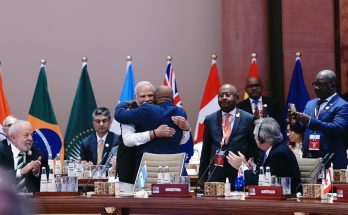
The Asia-Africa Growth Corridor has to be framed in the broader context of the African Agenda 2063. The agenda identifies seven key aspirations that are to be achieved over the next 50 years. The period is divided into 10-year implementation plans which allow for prioritization and easier monitoring of progress.
Seven Aspirations
The first aspiration of the Agenda 2063 is a prosperous Africa based on inclusive growth and sustainable development. Here we are not only talking about living standards, health and well-being, but also about well-educated citizens, about creating economies that are structurally transformed to create shared growth, looking at modern agriculture and taking advantage of Africa’s unique natural endowments.
The second aspiration is an integrated continent, politically united, based on the ideals of the pan-Africanism and rooted in the vision of Africa’s renaissance. This envisages integrative infrastructure, seamless borders and management of cross-border resources through dialogue. Infrastructure is important to support Africa’s accelerated integration and growth and technological transformation.
The third aspiration is a very fundamental one: how to achieve an Africa of good governance, democracy, respect for human rights, justice and the rule of law. In this context, there are enormous challenges that Africa has faced historically around the dearth of good governance.
The fourth one is about securing a peaceful and secure Africa.
The fifth one is an Africa with strong cultural identity, common heritage, values and ethics. The sixth is development that is people-driven, relying on the potential of African people, especially its women and youth and caring for children. The last aspiration speaks about an Africa that is a strong, united and influential global partner, so that it is no longer a continent about which people talk and make plans for, but one that is both able to have effective agency and at the same time actually to have a voice and influence on the global stage.
Synergies: Managing Partnerships
Looking at the Agenda 2063 and the Asia-Africa Growth Corridor, one can see certain synergies and overlaps.
The first issue is the management of strategic partnerships and projects or the proliferation and the increase in the number of strategic partnerships that Africa has with a number of actors from outside the continent. The challenge has always been about how we manage that in a way that is effective, in a way that ensures that we are moving forward and that we are progressing according to the objectives that each of these partnerships and plans has set out. It is an issue that has occupied the mind of the AU and features in the Kagame Report’s recommendations to reform the AU. In the discussions that have been held over the last year or so, there have been some proposals around how we manage that in a much more streamlined fashion because after all, Africa is a continent. It is easier to develop a strategy for one country than to develop a strategy for a continent with very diverse interests on some of these things.
There is a plan on the table which provides significant opportunities for cooperation to advance Agenda 2063, but there needs to be assurances from African bodies on the continent as well as individual countries that this development blueprint is ‘front of mind’ when they have both bilateral as well regional continental conversations.
Connectivity: Arc of Prosperity
What are some of these synergies that are very apparent in the Agenda as well as in the AAGC? The first is the infrastructure and institutional connectivity that is identified in the AAGC. Clearly, infrastructure is one of the big priorities of Agenda 2063. It is encapsulated in the AU’s Programme for Infrastructure Development in Africa (PIDA). In Africa, sub-regional bodies like SADC also have infrastructure plans and there is already a significant amount of cooperation with external actors in rolling them out. Of course, some of the challenges related to these infrastructure projects are that while there are some really big and ambitious ideas which are critical, if African states and regions are to realize their developmental objectives, the number of bankable projects is actually limited in comparison. That is something that the region has identified, but it is also a point that South Africa had been acutely aware of in its discussions around the BRICS New Development Bank when it was being negotiated. There is provision for a project preparation facility that is so necessary to move projects to bankability.
In addition, it is important to bear in mind that sometimes we think about infrastructure projects as big megaprojects. Discussions around the Agenda 2063 and the AAGC should emphasize that smaller projects can often be even more efficient and effective. Size does not matter necessarily in this context.
Soft Infrastructure: Japan Connect
Furthermore, while hard infrastructure is important, soft infrastructure is equally significant. This is sometimes ignored at our peril. Some of the soft infrastructure relates to the importance of harmonization of regulations. The AAGC refers to that in the context of trade facilitation. Some of the biggest barriers are around that constraint. Collaboration with India and Japan in this context could be very beneficial because Japan in the SADC context has been involved in rolling out one-stop border post, which can be an important basis from which to work.
Shaping Economic Corridors
Equally, when one talks about infrastructure and economic development, the role of cities in facilitating the creation of productive economies is crucial. We are talking about corridors in this context; cities are important links in mega corridors, connecting not only regions within a country but very significantly – and this is one of the points that is also being discussed at the sub regional level – linking hubs. Related to mega economic corridors is the need to assess the role that regional value chains can play. This has been front and centre of the priorities that have been identified by the Southern African Development Community in particular.
Three key sectors were identified in the sub-region as important in terms of developing regional value chains. One of those is pharmaceuticals; the other one is agro-processing and the third is mining. There are tremendous possibilities there for cooperation, both with local established companies in the region and also through creating linkages with small and medium enterprises because sometimes we forget about them when we talk about industrialization.
The last point, linked to SMMEs, is the importance of women not only as small and medium enterprise entrepreneurs, but lso as big enterprise entrepreneurs. This is part of the discussion happening in the region.
Implementation Plan
Mechanisms and structures for planning and implementation will also be important in collaboration. This is absolutely critical and hopefully this will happen soon as the NEPAD agency transforms into the Africa Development Agency. NEPAD is a natural partner. Equally so, African businesses and associations and chambers have to brought into the discussion. That is often a very difficult issue because Africa does not have as developed structures as India. But Africans should make use of what they have.
Initiatives such as the AAGC create significant opportunities for a network such as ours, the Network of Southern Think-Tanks, to both walk the path with it, and to do research on a number of these initiatives as these are rolled out. So, let us take it forward.
(Elizabeth Sidiropoulos is Chief Executive, South African Institute of International Affairs.)
Author Profile
- India Writes Network (www.indiawrites.org) is an emerging think tank and a media-publishing company focused on international affairs & the India Story. Centre for Global India Insights is the research arm of India Writes Network. To subscribe to India and the World, write to editor@indiawrites.org. A venture of TGII Media Private Limited, a leading media, publishing and consultancy company, IWN has carved a niche for balanced and exhaustive reporting and analysis of international affairs. Eminent personalities, politicians, diplomats, authors, strategy gurus and news-makers have contributed to India Writes Network, as also “India and the World,” a magazine focused on global affairs.
Latest entries
 In ConversationJuly 26, 2024India-Italy defence collaboration can extend to third countries: Anil Wadhwa
In ConversationJuly 26, 2024India-Italy defence collaboration can extend to third countries: Anil Wadhwa In ConversationJuly 23, 2024Italy views India as a key partner in Indo-Pacific: Vani Rao
In ConversationJuly 23, 2024Italy views India as a key partner in Indo-Pacific: Vani Rao DiplomacyJune 29, 2024First BRICS unveils a roadmap for boosting tourism among emerging economies
DiplomacyJune 29, 2024First BRICS unveils a roadmap for boosting tourism among emerging economies India and the WorldJune 11, 2024On Day 1, Jaishankar focuses on resolving standoff with China
India and the WorldJune 11, 2024On Day 1, Jaishankar focuses on resolving standoff with China






